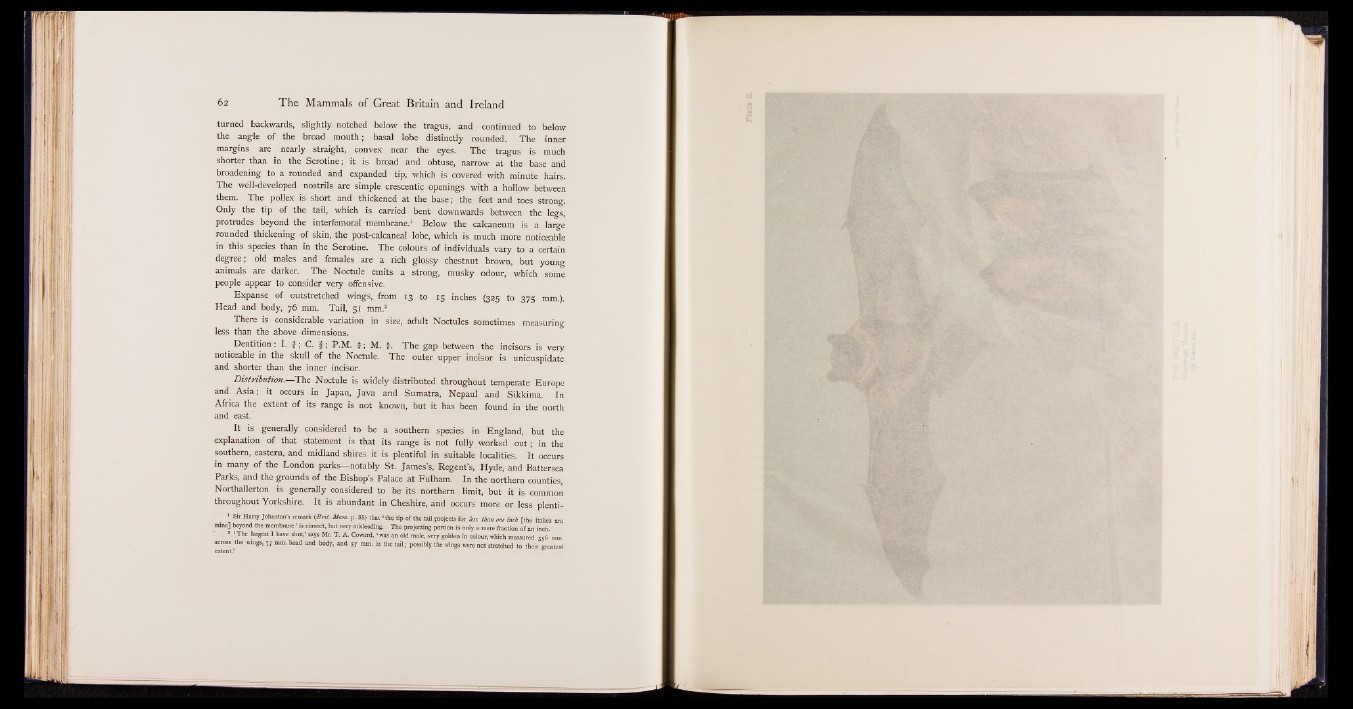
turned backwards, slightly notched below the tragus, and continued to below
the angle of the broad mouth; basal lobe distinctly rounded. The inner
margins are nearly straight, convex near the eyes. The tragus is much
shorter than in the Serotine; it is broad and obtuse, narrow at the base and
broadening to a rounded and expanded tip, which is covered with minute hairs.
The well-developed nostrils are simple crescentic openings with a hollow between
them. The pollex is short and thickened at the base; the feet and toes strong.
Only the tip of the tail, which ,1s: carried bent downwards between the legs,
protrudes beyond the interfemoral membrane.1 Below the calcaneum is a large
rounded thickening of skin, the post-calcaneal lobe, which is much more noticeable
in this species than in the Serotine. The colours of individuals vary to a certain
degree; old males and females are a rich glossy chestnut brown, but young
animals are darker. The Noctule emits a strong, musky odour,, which some
people appear to consider very oifensive.
Expanse of outstretched wings, from 13 to 15 inches (325 to 375 mm.).
Head and body, 76 mm. Tail, 51 mm.!
There is considerable variation in size, adult Noctules sometimes measuring
less than the above dimensions.
Dentition: I. 4 ; C. #; P.M. i ; M. $. The gap between the incisors is very
noticeable in the skull of the Noctule. The outer upper incisor iSj-unicuspidate
and shorter than the inner incisor.
Distribution.— The Noctule is widely distributed throughout temperate Europe
and Asia; it occurs in Japan, Java and Sumatra, Nepaul and Sikkima. In
Africa the extent of its range is not known, but it has been found in the north
and east.
It is generally considered to be a southern species in England, but the
explanation of that statement is that its range is not fully worked out; in the
southern, eastern, and midland shires it is plentiful in suitable localities. It occurs
in many of the London parks— notably St. James’s, Regent’s, Hyde, and Battersea
Parks, and the grounds of the Bishop’s Palace at Fulham. In the northern counties,
Northallerton is generally considered to be its northern limit, but it is common
throughout Yorkshire. It is abundant in Cheshire, and occurs more or less plenti-
1 Sh Harry Johnston's remark (B rit. Mam. p. 88) that ‘ the tip of the tail projects for less than one inch [the italics are
mine] beyond the membrane ’ is correct, but very misleading. The projecting portion is only a mere fraction of an inch.
* 1 The largest I have shot,' says Mr. T. A. Coward, ‘ was an old male, very golden in colour, which measured 356* mm.
across the wings, 77 mm. head and body, and 57 mm. in the tail; possibly the wings were not stretched to their greatest